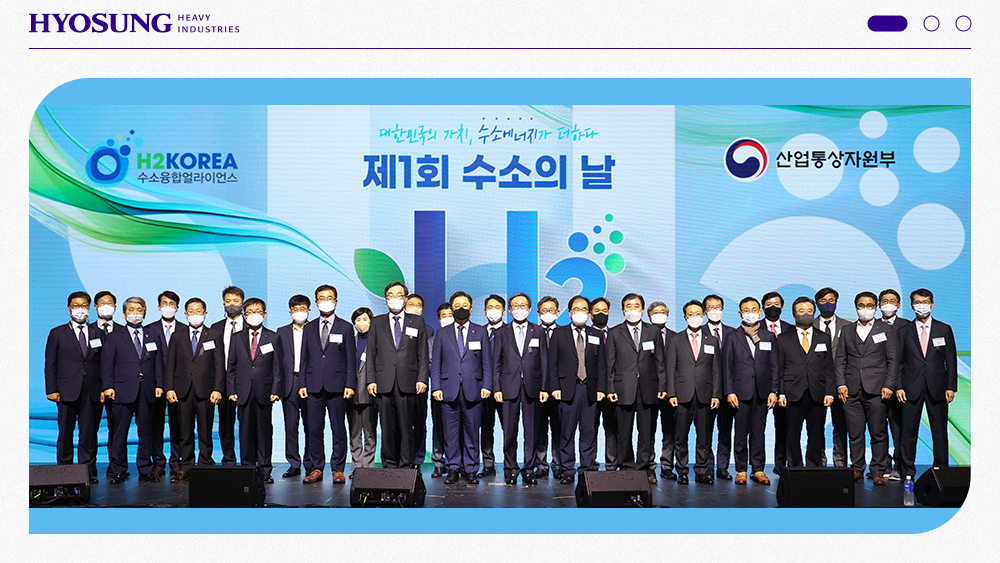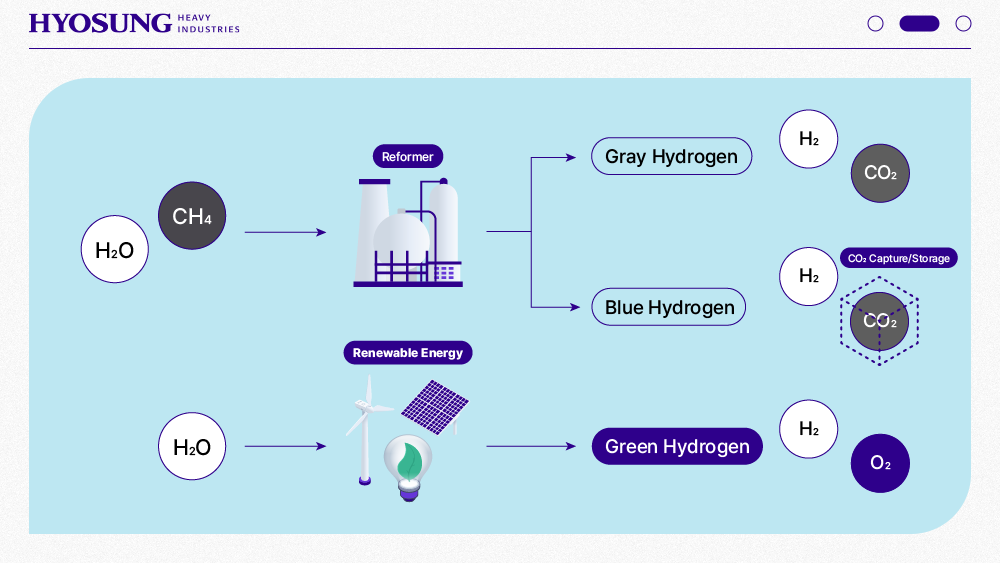Brand Journalism
Brand Journalism
2023-06-16
Green hydrogen, bringing closer a green eco-friendly future
On November 2nd of last year, a remarkable ceremony was held, taking us a step closer to an eco-friendly green future. It was Hydrogen Day. The Ministry of Trade, Industry and Energy, along with the Hydrogen Fusion Alliance (H2KOREA), designated November 2nd as South Korea's Hydrogen Day, symbolized by the elemental symbol H2, and hosted the first ceremony last year. Jeong Sang-yeol, head of Hyosung Heavy Industries, received a commendation from the Minister of Trade, Industry and Energy for his contributions to developing the hydrogen industry, which include introducing core technology from abroad and expanding hydrogen refueling infrastructure. As concern for the environment rises and various external factors contribute to uncertainties in the energy supply, a swift transition from a carbon-based-economy to a hydrogen economy is underway. As a result, hydrogen, the key to sustainable alternative energy, is gaining attention, particularly blue and green hydrogen, which excludes carbon dioxide-emitting grey/brown hydrogen. Green hydrogen is produced by electrolyzing water using renewable energy-generated electricity. Although its production cost is currently higher than other forms of hydrogen, the long-term trend reveals a decrease in green hydrogen production costs, mitigating its drawbacks. Conversely, as regulations tighten in accordance with global climate policies, the limitations of carbon dioxide-emitting grey, brown, and blue hydrogen become increasingly apparent. Green hydrogen appears to be the most promising energy source for the future.

Hydrogen color deferred by the manufacturing process
Hydrogen is getting attention because it is a clean fuel that doesn’t emit carbon dioxide when it burns and has endless applications, including hydrogen vehicles and fuel cells. Hydrogen is a colorless, odorless, tasteless, lightweight gas, constituting 75% of the universe and a plentiful resource from water. Since hydrogen combustion produces water vapor, there is no concern about depletion. Hydrogen does not exist as a single element (element symbol H), but in compound forms such as water (H2O). In order to utilize hydrogen as an energy source, it must be separated from other compounds through a preliminary process. There are three primary methods for obtaining hydrogen: 'byproduct hydrogen' produced as a byproduct of petrochemical processes or steel manufacturing, 'reformed hydrogen' generated by decomposing natural gas at high temperatures and pressures, and 'electrolyzed hydrogen' produced by the electrolysis of water.
Among the hydrogen produced in this manner, byproduct hydrogen and reformed hydrogen are categorized as grey hydrogen. Byproduct hydrogen has limitations in increasing production since it is generated as a byproduct in petrochemical and steel plants, while reformed hydrogen allows for mass production but produces a significant amount of carbon dioxide as a byproduct. Blue hydrogen addresses these limitations. Blue hydrogen shares the same production method as grey hydrogen, but carbon dioxide generated during the process is captured, utilized, and stored. The CCUS technology is employed to remove it, leading to its classification as clean hydrogen. The captured carbon dioxide is stored or used in cement, semiconductor gases, tire materials, and other applications, earning blue hydrogen recognition as a viable renewable energy alternative.

Green Hydrogen, the real eco-friendly hydrogen with no carbon emissions
Hydrogen exists that does not emit carbon dioxide during its production process. This is carbon-neutral, truly eco-friendly hydrogen, known as green hydrogen. Green hydrogen is produced through water electrolysis, using electricity generated from renewable energy sources, such as solar and wind power, to separate hydrogen and oxygen. Not only does the water electrolysis method have the advantage of zero carbon emissions, but it also addresses the intermittency of renewable energy sources that rely on variable weather conditions by converting and storing electricity into hydrogen as an energy carrier, thus mitigating rapid uncertainties in the power grid.
Hyosung, pioneering the new age of green hydrogen
As a leading company in renewable energy, Hyosung is dedicated to producing green hydrogen. Hyosung was the first company in South Korea to develop a 750 kW wind turbine and is trying to get KS certification for 10 MW offshore wind turbine. Hyosung also has a leading position in the domestic energy storage system (ESS) market, essential of stabilizing renewable energy output. Leveraging its extensive know-how and technological prowess in renewable energy, Hyosung aims to expedite the energy transition towards green hydrogen and usher in a new era of hydrogen-based solutions.

Hyosung plans to invest KRW 1 trillion to build an offshore wind power assembly plant in the Jeonnam by 2030, thereby establishing a green hydrogen production system utilizing renewable energy. Having signed an agreement with Jeollanam-do on fostering the green hydrogen industry, Hyosung aims to construction of the country's largest-scale 10 MW-class electrolysis facility this year, with a goal to increase annual green hydrogen production capacity to 200,000 tons. Additionally, the company plans to lead the dawn of the green hydrogen era by building two 10,000-ton-per-year liquefied hydrogen plants for storage and utilization and installing liquefied hydrogen refueling stations in nine key areas of Jeollanam-do.
Moreover, Hyosung Heavy Industries has been supplying gaseous hydrogen refueling systems in response to the growing demand for hydrogen fuel cell vehicles and commercial hydrogen vehicles based on the hydrogen economy. Through a technological partnership with Linde, the only company globally with a commercialized liquefied hydrogen refueling station model, Hyosung is planning and promoting the construction of domestic liquefied hydrogen refueling stations. In addition to developing green hydrogen fuel, the company also plans to expand hydrogen refueling stations and develop supply technologies to expedite commercialization of hydrogen fuel.
As the world transitions to a hydrogen economy, green hydrogen has been gaining attention as a clean energy source as it emits no carbon dioxide and relies on renewable energy. Despite its many benefits, the high cost of green hydrogen makes it unsuitable as an alternative energy source. According to a recent analysis by London-based firm ICIS, as of November 9th last year, the price of green hydrogen under renewable energy power purchase agreements (PPAs) remained stable at £3.99, while the cost of grey hydrogen increased approximately 20% to £4.16 per kilogram. Due to the concerns over environmental and climate crises and factors like the Russian-Ukrainian war, gray hydrogen prices are always volatile and have uncertainties in the energy supply. As global climate policies tighten and carbon-emitting energy becomes more limited, green hydrogen is expected to establish itself as stable, as a carbon-neutral raw material. Hyosung, which has the best expertise in renewable energy domestically, has the technological capabilities and infrastructure to accelerate the transition to green hydrogen that utilizes renewable energy. With advanced expertise in renewable energy and green hydrogen, Hyosung is actively contributing to the widespread adoption of green hydrogen through proactive investment and R&D. The realization of an eco-friendly green future with green hydrogen is becoming an achievable reality, and Hyosung is leading the way to a greener future.